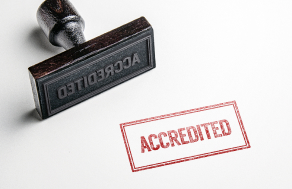

What is Accreditation?
Accreditation is the process to ensure that school, post-secondary institutions, and other education providers meet, and maintain minimum standards of quality and integrity regarding academics, administration, and related services. The Council of Higher Education Accreditation (CHEA) defines accreditation as “A review of the quality of higher education institutions and programs. In the United States, accreditation is a major way that students, families, government officials, and press know that an institution or program provides a quality education”.
THE ACCREDITATION PROCESS

Benefits of Accreditation
Accreditation” is the primary means of assuring and improving the quality of higher education institutions and programs in the United States. Active for the past 100 years, this private, voluntary system of self-examination and peer review has been central to the creation of a U.S. higher education enterprise that is outstanding in many respects.
The primary public symbol of legitimate higher education for over 100 years
- A key litmus test of threshold academic quality
- Approximately 7,600 higher education institutions and more than 23,500 programs accredited as of 2017
Successful in encouraging major innovation while maintaining quality over the years, which include:
- The development of community colleges
- The growth of for-profit higher education
- The advent of online learning, schools, programs and classes
- The emergence of innovative non-institutional providers
Central to states carrying out licensure of the professions
- Many states require that professional programs be accredited and require that individuals who sit for licensure examinations in various professions graduate from accredited programs
Protection against fraud and abuse for students and consumers
- Primary barrier against degree mills, accreditation mills and visa mills
- Maintain standards that hold institutions and programs accountable for the integrity of their work with students and the information they provide the public
Essential to international mobility
- Vital to international students, governments and higher education institutions for judgments about transfer of credit, recognition of qualifications and degrees, and judgments about entry to U.S. higher education from other countries
Responsive to current climate of accountability and equipped to meet current challenges
- Development of student learning outcomes
- Greater transparency about institutional and program performance
- Improving transfer credit
The primary “reliable authority” for federal and state governments funding for higher education
- Accreditation required for student access to federal and state grants and loans, now $170 billion annually
- Accreditation required for institution and program access to other federal funds for research and programs or funds for operating in some states
The primary reliable authority for private sector financial support for higher education
- The primary reliable authority for private sector financial support for higher education
Vital to maintaining key features of higher education that have contributed to the enterprise as among the best in the world
- A diverse array of institutions
- A mission-based system
- Responsible institutional independence for academic judgment
- Responsible academic freedom

Programs for Review
The following programs are proposed for review in 2024. Comments regarding accreditation review of any of these programs should be submitted to the JRCERT Chief Executive Officer no later than 60 days before the projected date.
LEARN MORE
Monthly Statistics
Each month the JRCERT publishes statistics regarding the number of accredited programs. Click the learn more button to view the statistics.
LEARN MORE
Board Meeting Summaries
Board meeting summaries include discussion and actions taken by the board of directors at the semi-annual board meetings in Chicago.
Learn More













